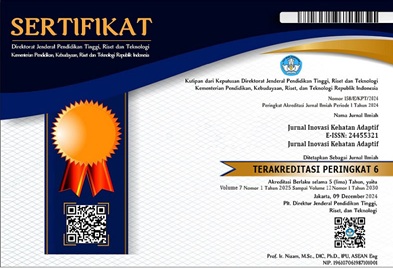| ..:: MAIN MENU ::.. |
| About The Journal |
| Focus & Scope |
| Peer Review Process |
| Author Guidelines |
| Publishing System |
| Privacy Statement |
| Copyright & License |
| Author Fees |
| Contact Us |
Author Guidelines
Author Guidelines
- Articles written in Indonesia with a distance of 1 line spacing, A4 size, between 4000-8000 words, 3 cm margin. Articles typed using MS Word with Times New Roman font 12 pt, and then the article submitted to a Jurnal Inovasi Kesehatan Adaptif Journal in (web: https://jurnalhost.com/index.php/jika/index).
- Articles include an abstract (between 100-150 words) and keywords (maximum 5 words / phrases) written one space. Abstract written in English for Indonesia article. While the article is in English then abstract written in Indonesian.
- Articles that have been presented in the seminar can be received by mentioning the identity.
- Incoming articles can be accepted or rejected by the Editorial Board and will be informed to the author.
- Turnitin plagiarism test result is a maximum of 20%. If it is more than that then the article cannot be processed (rejected).
- Jejak Pembelajaran: Jurnal Pengembangan Pendidikan editorial team reserves the right to edit as necessary editorial, so it will not affect the originality of writing.
- Articles that have been presented at scientific seminars should be given information on the first page.
- Article submission is no later than the end of January for the February issue, the end of April for the May issue, the end of July for the August issue and the end of October for the November issue.
- Include a brief bio (name, institution/department, education, profession and monumental works and phone number)
- Writing system :
- Title nuanced national or global (research location described in the methods, not mentioned in the title). The author identity of the institution and e-mail address.
- Abstract in Indonesia and English between 150-200 words, containing the core of the problem / research background, the way of research / problem solved, objectives, methods and findings obtained as well as the novelty and / originality, conclusions and recommendations. Included Keywords consisting of 3-5 words that became the core of the abstract description.
- Introduction (approximately maximum 20% of words) contain: (a) exposure of the background, (b) mapping the latest developments in science studied that the argument is supported by the researches finding and study of the primary and advanced literature (journals) (last 3-5 years); (c) exposure of the gap; (d) the arguments of researchers in filling / closing these gaps as a research promise for the contributions of science development; and (e) the exposure of research purposes.
- Methods(maximum 20% of words) contain an exposition of everything that was done by researchers in conducting the research clearly seemed to give other researchers the opportunity to replicate or verify the research. Avoid definitions quoted from the book in the Methods exposure. The research design which has become common knowledge there should be no sources are cited.
- Results (maximum 20%) and Discussions(30-40%) presented sequentially or integrated in the "Results and Discussion".
- Exposure in the Results section contains a description of results of data analysis. Presented in accordance with research problem and / research purpose or research hypothesis. If there are tables / charts / images, it should contain the exposure of analysis result that has been meaningful and easy to understand. Tables / charts / pictures do not contain raw data that are still need processed.
- Exposure to the Discussions section giving substantially meaning to the results of the analysis and comparison with previous findings based on the relevant of literature review, advanced and primary research (about 50% of the journal reference used here). The comparison should lead to their differences with previous research findings so that have potential to express a contribution to the development of science.
- Conclussions and Recommendations (maximum 1 page)
- In the form paragraphs (not numerical)
- Contain research findings as a synthesis between the results of the discussions
- More featuring new things that contribute to the development of science.
- Avoid the use of technical terms of statistics and methodology.
- Acknowledgements contain appreciation to the various parties directly related to the research and their contribution; If the research is funded by donors, please mentioned the decree or contract number.
- References contain all referenced in the text that comes from a source which (a) relevant, (b) at least 80% from advanced research (last 5 years), and (c) at least 80% of primary. The Bibliography at the end of the manuscript must be written in the APA Citation Style (American Psychological Association). Citations are only items that you have used on footnotes or bodynotes. Please use Reference Manager Apps like EndNote, Mendeley, Zotero, etc. All publications cited in the text should be included as a Bibliography list, arranged alphabetically by the author.
- Appendices which is necessary if any.
-
Authors must commit to completing the article through from submission to publication. If the author does not complete the article to the end, despite his or her expressed ability, the author will be placed on Jurnal Inovasi Kesehatan Adaptif Journal's blacklist permanently





